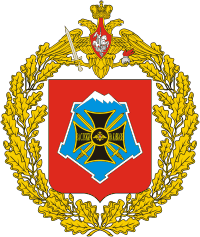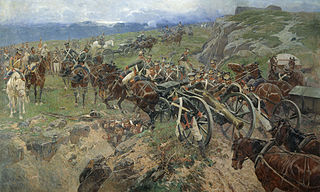Before the creation of the Caucasus Military District in 1865, Russian forces in the Caucasus were organized, at different times, in a number of formations under various names.
Before the creation of the Caucasus Military District in 1865, Russian forces in the Caucasus were organized, at different times, in a number of formations under various names.
In 1777, the Russian troops located at Kizlyar and along the entire borderline of the Terek River were formed into a body subordinate to the governor of Astrakhan. Into this corps were subsumed the Karbadian and Gorski jaeger battalions from the garrison of Kizlyar, and one battalion of the garrison of the town of Mozdok.
In 1779, this body was strengthened with the arrival at Astrakhan of the Selege, Tomsk, and Ladoga infantry regiments.
In the autumn of 1782, this body, having been further strengthened in the meantime, was named the Novolineyny Corps, and then soon renamed the Caucasus Corps. By then, the Corps consisted of 22 infantry battalions, 20 squadrons of dragoons, and four batteries of artillery (30 guns).
In early 1796, the Tsarina Catherine II, having decided to declare war on Persia, ordered that the Corps be strengthened with the addition of four infantry regiments, 3 legkokonnymi regiments, and one Cossack regiment.
The troops chosen to participate in the Persian Expedition of 1796 were organized into the Caspian Corps under Count Zubov. This Corps consisted of six battalions of grenadiers, twelve battalions of musketeers, seven jaeger battalions, and 45 squadrons of cavalry. After the death of Catherine, her successor Paul I halted military operations against Persia and withdrew all the troops stationed on the Caspian and in Georgia back into Russia.
In November 1796, an Imperial Order established a reorganization of all regiments. The troops were formed into 12 divisions, and soon renamed the Inspectorate. Troops stationed in the Caucasus became the Tenth Caucasian Division. The Caspian Corps was disbanded and its troops reassigned to organizations which had been withdrawn into the internal provinces of Russia.
In 1801, at time of the accession to the throne of Tsar Alexander I, the troops in the Caucasian Inspectorate consisted of 15 infantry battalions, 20 squadrons of dragoons, and 5 artillery batteries.
On December 21, 1815, by Imperial Order, the troops of the 19th and 20th divisions, located on the Caucasian border, in Georgia, and in the Transcaucasian region in general, were formed into a separate Georgia Corps.
In early 1819, the commander in Georgia, General Ermolov, requested a strengthening of the forces in the region. Tsar Alexander I did not feel able to do this on a permanent basis, but on April 19 sent ten regiments as a temporary reinforcement.
In August 1820, an Imperial Order was issued decreeing that some troops in the Georgia Corps be formed into a separate Caucasus Corps.
On December 6, 1857, the Caucasus Corps was renamed the Caucasus Army, and the post of Chief of the Caucasus Army General Staff was created.
In August 1865, the Caucasus Military District was created, and the general staff of the Caucasus Army was abolished, although the army was not formally abolished in name until 1881.

Aleksey Petrovich Yermolov was a Russian general of the 19th century who commanded Russian troops in the Caucasian War. He served in all the Russian campaigns against the French, except for the 1799 campaigns of Alexander Suvorov in northern Italy and Switzerland. During this time he was accused of conspiracy against Paul I and sentenced to exile. Two years later he was pardoned and brought back into service by Alexander I. Yermolov distinguished himself during the Napoleonic Wars at the Battles of Austerlitz, Eylau, Borodino, Kulm, and Paris.

The Turkish Third Army is a field army of the Turkish Army and is the country's largest army.
The following units of the German First Army and British Expeditionary Force fought in the Battle of Mons in World War I.

The North Caucasus Military District was a military district of the Russian Armed Forces from 1992-2010. Before 1992 it had been part of the Soviet Armed Forces since 1918. In 2010 it became the Southern Military District and lately also included the Black Sea Fleet and Caspian Flotilla.
The Imperial Russian Army in June 1812 consisted of three main armies and other military formations. The Commander in Chief of the Army was Emperor Alexander I.

The Russian Caucasus Army of World War I was the Russian field army that fought in the Caucasus Campaign and Persian Campaign of World War I. It was renowned for inflicting heavy casualties on the opposing forces of the Ottoman Empire, particularly at the Battle of Sarikamish. It was also known for its extremely diverse ethnic composition, consisting of units from throughout the Russian Empire and both soldiers and officers from the many ethnic communities settled since the 1877-78 Russo-Turkish War in the militarily administered Kars Oblast in the Russian Transcaucasus. These included Georgians, Caucasus Greeks, and Armenians - the latter in particular strongly represented among both the soldiers and senior officers - as well as ethnic Russians and Ukrainians.
The 131st Separate Motor Rifle Brigade was a motorised infantry unit of the Soviet Army and of the Russian Ground Forces.

The Russian conquest of the Caucasus mainly occurred between 1800 and 1864. The Russian Empire sought to control the region between the Black Sea and Caspian Sea. South of the mountains was the territory that is modern Armenia, Azerbaijan, Georgia, and parts of Iran and Turkey. North of the mountains was the North Caucasus region of modern Russia. The difficult conquest of the intervening mountains is known as the Caucasian War. Multiple wars were fought against the local rulers of the regions, as well as the dominant powers, the Ottoman Empire and Qajar Iran, for control. By 1864 the last regions were brought under Russian control.

The Battle of Czarnowo on the night of 23–24 December 1806 saw troops of the First French Empire under the eye of Emperor Napoleon I launch an evening assault crossing of the Wkra River against Lieutenant General Alexander Ivanovich Ostermann-Tolstoy's defending Russian Empire forces. The attackers, part of Marshal Louis-Nicolas Davout's III Corps, succeeded in crossing the Wkra at its mouth and pressed eastward to the village of Czarnowo. After an all-night struggle, the Russian commander withdrew his troops to the east, ending this War of the Fourth Coalition action. Czarnowo is located on the north bank of the Narew River 33 kilometres (21 mi) north-northwest of Warsaw, Poland.

The Southern Military District is a military district of Russia.
The North Caucasus Operation was a strategic offensive conducted by the Caucasian Front of the Red Army against the White Armed Forces of South Russia in the North Caucasus region between 17 January and 7 April 1920. It took place on the Southern Front of the Russian Civil War and was a Soviet attempt to destroy White resistance.

The siege of Derbent took place on 21 May [O.S. 10 May] 1796 during the Persian Expedition of 1796. Derbent, an ancient city with thick walls has a favorable geopolitical position, which locks the coastal passage between the Caucasus Mountains and the Caspian.
The Caspian-Caucasian Front was a front of the Red Army during the Russian Civil War, formed on 8 December 1918 as a branch of the Southern Front. The Front was disbanded on 13 March 1919 and the troops transferred to form a separate 11th Army.

The Northern Caucasus Operation was fought between the White and Red Armies during the Russian Civil War between December 1918 and March 1919. The White Army captured the entire Northern Caucasus. The Red Army withdrew to Astrahan and the Volga delta.

The Battle of Choloki took place on 4 June 1854 on the outskirts of village Kakuti in Guria during the Crimean war.
The 414th Rifle Division was twice formed as an infantry division of the Red Army; very briefly in the winter of 1941/42, then from the spring of 1942 until after May 1945. It was officially considered a Georgian National division, having nearly all its personnel of that nationality in its second formation. After its second formation it remained in service in the Caucasus near the borders of Turkey and Iran in the 44th Army until the summer of 1942, when it was redeployed to help counter the German drive toward Grozny. As German Army Group A retreated from the Caucasus in January 1943 the division was reassigned to the 37th Army in North Caucasus Front, and during the fighting in the Taman Peninsula during the summer it served in both the 58th and 18th Armies, earning a battle honor in the process. It entered the Crimea during the Kerch–Eltigen Operation in November, and was awarded the Order of the Red Banner following the offensive that liberated that region in April and May 1944, fighting in the 11th Guards Rifle Corps of the Separate Coastal Army. After the Crimea was cleared the Coastal Army remained as a garrison and the 414th stayed there for the duration of the war. Postwar, it was relocated to Tbilisi, being renumbered as the 74th Rifle Division in 1955 and disbanded the following year.
The 110th Cavalry Division was a horsed cavalry division of the Soviet Union's Red Army during World War II. It was formed in January 1942 as the 110th Separate Cavalry Division and reformed as the 110th Cavalry Division on 30 September 1942. Formed as a Kalmyk national division, its personnel were drawn from the Kalmyk Autonomous Soviet Socialist Republic.
The Battle of Gordali was one of the fiercest battles of the Caucasian War. The battle between the Separate Caucasian Corps of the Caucasian Army under the command of Colonel Baklanov and the Chechen troops under the leadership of Naibs Eski and Talkhig took place on August 11, 1852, near the village of Gurdali, located on the Michik River. The purpose of the campaign was to destroy the village of Gordali. The Russians managed to break into the village, but due to heavy losses Baklanov was forced to retreat.

The 51st Lithuanian Infantry Regiment, known as the 51st Lithuanian Infantry Regiment of His Imperial Highness Heir to the Tsarevich from 1904, was an infantry regiment that served in the Imperial Russian Army.
The 20th Finnish Dragoon Regiment was a cavalry regiment of the Imperial Russian Army which saw service during the later half of the 19th Century and beginning of the 20th before disbanding following the October Revolution. Three regiments went by the name of 'Finnish Dragoon Regiment', of which the 20th was the last.